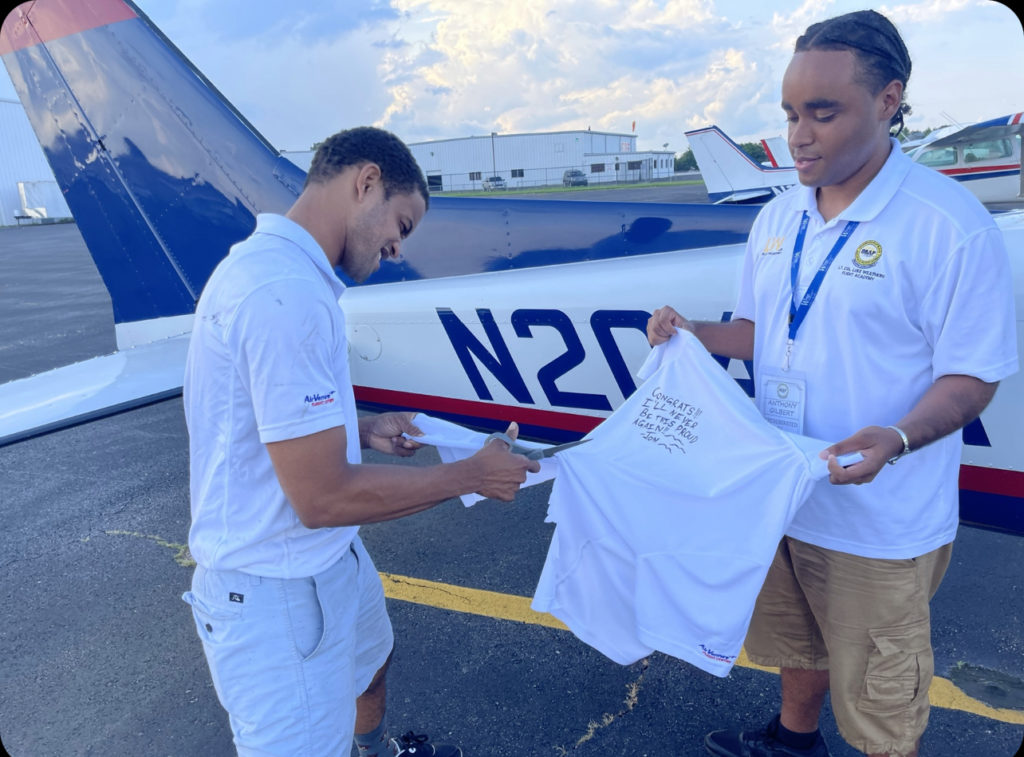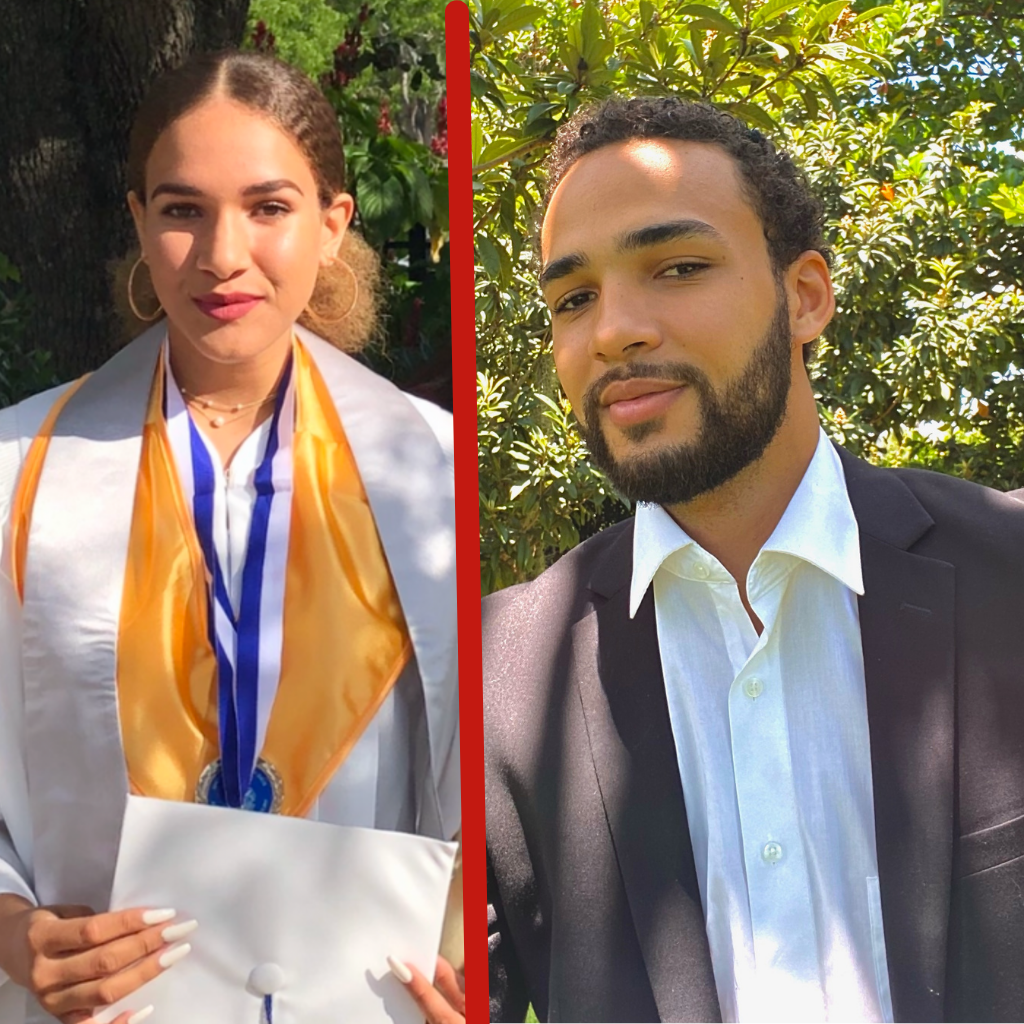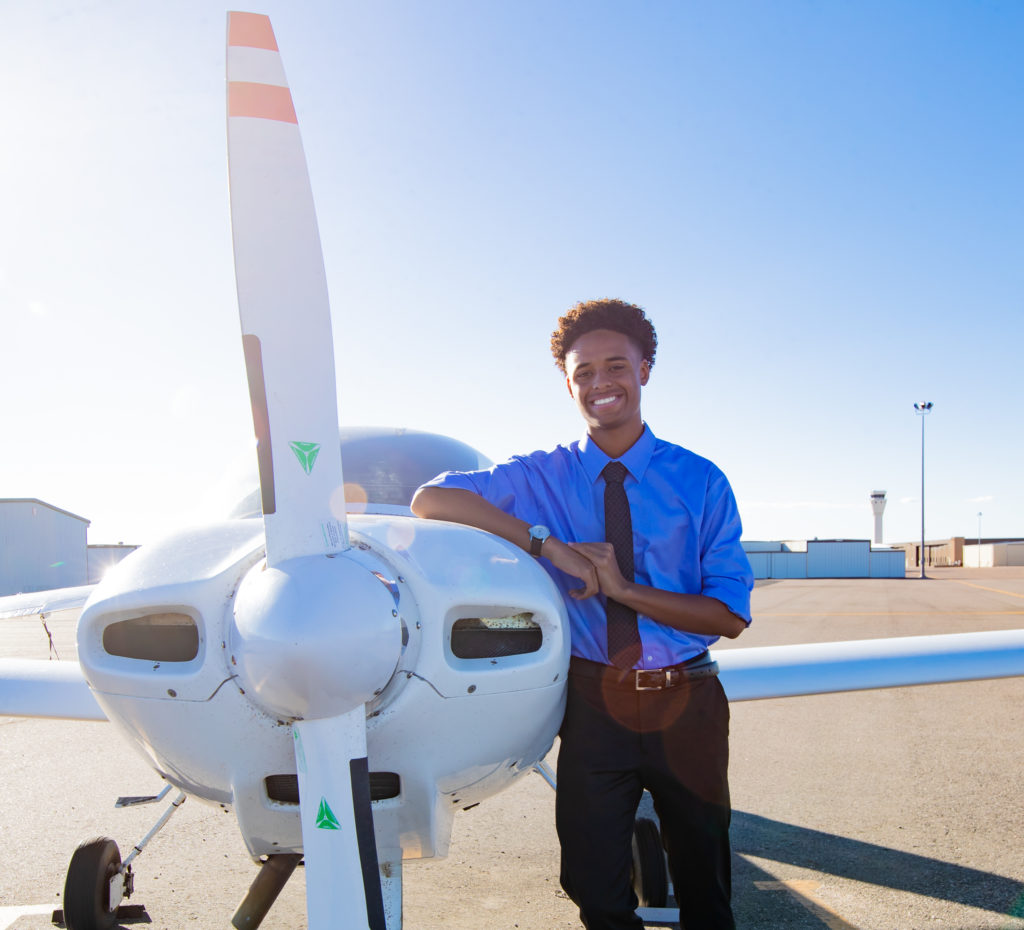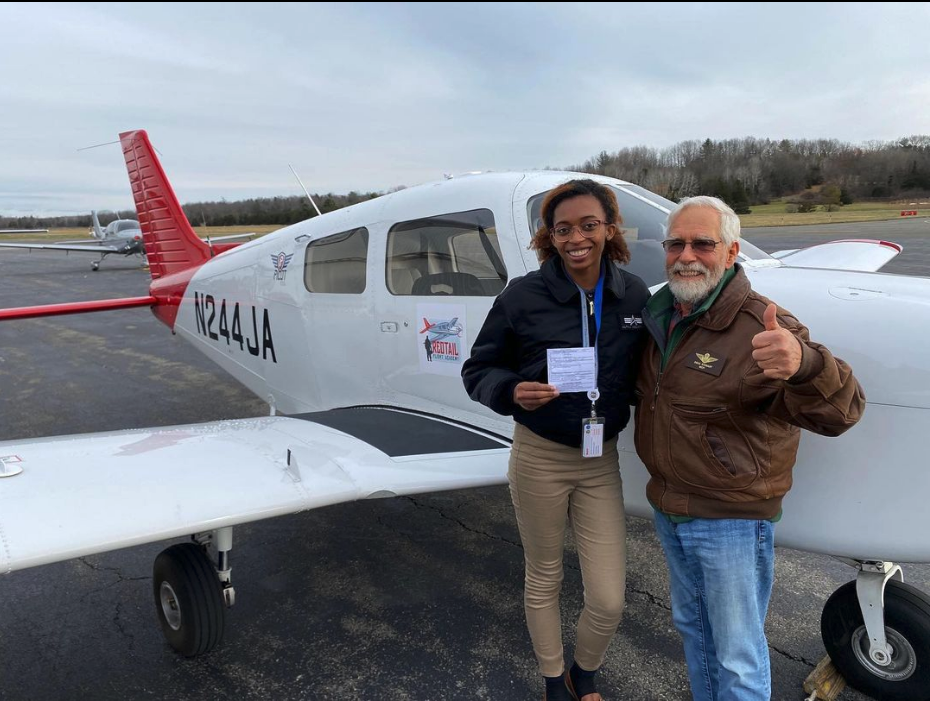Eighty years after the first Black Army Air Corps aviation cadets graduated from military flight training at Alabama’s Tuskegee Institute, members of the inaugural graduating class at New York’s RedTail Flight Academy vowed to begin aviation careers inspired by the original Tuskegee Airmen’s legacy.
The RedTail Flight Academy (RFA) program –– based at New York Stewart International Airport and operated as a project of the Major General Irene Trowell-Harris chapter of Tuskegee Airmen, Inc. and its Lee A. Archer Jr. Redtail Youth Flying Program –– was designed to create a Tuskegee Airmen-inspired pipeline to career possibilities for underrepresented people of color.
The six 2022 graduates –– Mya Coley, siblings Calvin Frederick and Jasmine Frederick, Anthony Gilbert, Traye Jackson, and Jarious Gordon –– all received private pilot certificates and drone certificates, while five received instrument, commercial, and commercial multi-engine ratings. Two have received advanced ground instructor certifications and three received certified flight instructor ratings and plan to volunteer to help train the next class of RFA pilots.
RFA operations manager Tanya Austin says the six inaugural graduates represent both humble beginnings and tremendous symbolism.
“This is the 80th anniversary of the Tuskegee Airmen, whose first class graduated in 1942 with only five students,” Austin says, noting that the Tuskegee Airmen ultimately numbered almost 14,000. “They graduated five in their first class and we’re graduating six –– so we’re starting similarly small and dreaming very big.”
One of Austin’s primary goals is moving the needle on some of the abysmally low statistics on representation of people of color in the aviation industry, particularly Black pilots. Though the Tuskegee Airmen broke through racial barriers in aviation 80 years ago, the passing decades have proven that many of those barriers remain in place.
“Black males represent approximately percent of military aviators and only 3.9 percent of commercial aviators. Black females represent less than one percent both military and commercial airline aviators,” Austin says. “We are virtually nowhere to be found in aviation, but I see the RedTail Flight Academy program as a catalyst and as a template. In just under ten months, including three weeks off for Christmas and with the winds and weather of this Northeast Region, we’ve been able to help these six students get to where some of them are already certified flight instructors.”
Diversity, equity, and inclusion matter, Austin says, and many leaders in the aviation industry finally get it. Those words are meaningless without direct action to address shortcomings, though, especially with the high cost of flight training as a barrier to entry.
“There’s a lot of talk in our industry about an overall pilot shortage and now, finally, the aviation industry is truly reckoning with diversity, equity and inclusion as an added layer to that shortage,” Austin says. She’s heard from many aviation business leaders eager to do better on the diversity hiring front, but there just aren’t that many Black pilots available: all told, Black pilots represent about two percent of aviators across commercial and military aviation, a percentage that hasn’t changed much since the 1940s. Austin says she’s on a mission to double the percentage of minority aviators over the next 10 years to at least four percent, partly by offering full scholarships to make flight training free of cost for RFA students, and partly by helping Tuskegee Airmen chapters across the country replicate the project with their own flight academies.
“The biggest win from our first year, I would say, is that we’ve introduced our students to more than just flying aircraft. Yes, we help these students learn how to fly, but we also further their development by introducing them to industry leaders and to organizations like NATA, NBAA, and NAA,” Austin says. “We’re introducing them to leaders at a variety of companies and at a variety of levels to give them a strong sense of all the career possibilities in aviation. They have been introduced to people like four-star General Lloyd Newton, the first African-American Thunderbird pilot, and they’ve been introduced to people who have already offered them internships or jobs. I can say with certainty that the majority of our students would not be exposed to these types of opportunities or individuals without this program and its supporters.”
While other barriers loom large, Austin says the first and easiest way to attract people from underrepresented communities to aviation is to address the cost-of-entry barrier. She estimates that RFA spent close to $100,000 per student to get its first six graduates across the stage, a cost she’s aiming to bring down as the program scales up: RFA is planning to offer scholarships to 18 students in its incoming Class of 2023.
“A reason why Black people are not represented in aviation is that $100,000 is a heavy lift for anybody, but especially individuals from marginalized groups that have dealt with all kinds of barriers,” Austin says. “I see our organization really being a springboard: we take students of different backgrounds from across the United States and we help them with all facets of their life. We mentor them, give them leadership training, show them how to fly, and introduce them to viable streams of income in aviation – not just as a pilot.”
RFA is a new program of the Lee Archer Jr. Redtail Youth Flying program, a non-profit organization started 20 years ago to help introduce elementary, middle, and high school students to aviation. It’s named for Archer, a fighter pilot credited with shooting down four enemy aircraft over 169 combat missions with the Tuskegee Airmen during World War II; he died in 2010. The program was started through the New York-based Major General Irene Trowell-Harris chapter of Tuskegee Airmen, Inc. (Trowell-Harris, 82, is a two-star general, the first African-American to earn that title in the National Guard).
Austin aims to take the RFA template to all 53 other chapters of the Tuskegee Airmen across the country.
“A lot of companies are working towards diversity, equity, and inclusion goals, but they need talent to choose from. Our organization fits in by preparing people; the more visible we are, the more companies will be able to tap into diverse groups to recruit talent,” she says. “We want to perpetuate the legacy of the Tuskegee Airmen by moving aviation forward.”
Austin says the Class of 2022 gives her tremendous hope.
“We’ve watched them mature in just a few short months. They have become brand ambassadors, traveling across the country and representing the Redtail Flight Academy and the Tuskegee Airmen organization with pride and discipline — and they’ve been able to come back and still knock out these aggressive flight training deadlines. I’m really proud of the fact that we’re really changing lives.”
The program is scaling up quickly: after offering six scholarships for the Class of 2022, RFA is offering 18 for the Class of 2023.
“As we increase their numbers, RFA students are going to keep the Tuskegee Airmen legacy alive. There may be 130 of the original 14,000 Tuskegee Airmen left around the world, and they’re close to 100 years old. Soon, they’ll be gone, but these young people will continue their legacy. This chapter of Black history in aviation still needs to be told, because a lot of people don’t know the Tuskegee Airmen’s story. Maybe people have seen the George Lucas film, but looking at the percentage of Black aviation professionals, it seems like a lot of people still don’t know that this is a path we can take.”
Austin says she’s proud that NATA has pledged ongoing support, beginning in RFA’s inaugural year – one of more than 35 organizations to do so, including several NATA member companies.
“What we want is to even the playing field and to help the aviation field, period,” she says. “We want to help alleviate the pilot shortage, while at the same time help with diversity, equity, and inclusion in the industry. I’ve actually thought, ‘why is diversity, equity, and inclusion even a thing?’ It shouldn’t be a thing. But it has to be a thing until we address the elephant in the room. Until the playing field is level there’s always going to be an imbalance, and that keeps us divided. When we can all work together, really great things start to happen.”
NATA asked Austin to share a bit about each of the first six RFA graduates.

Anthony Gilbert
“Our youngest student, a 19-year-old from the island of St. Croix, has been wanting to fly since the age of five. He received a scholarship to attend RFA through the Tuskegee Airmen chapter in St. Croix. When he leaves here, he will intern at Baldwin Safety & Compliance before attending college at Embry-Riddle Aeronautical University. His goal is to ultimately work for the airlines out of St. Croix.”

Jasmine and Calvin Frederick
“These siblings from Homestead, Florida, were introduced to aviation at a young age: their mother has been a flight attendant for more than 25 years and they have both always had an affinity for flying. Jasmine was our very first female private pilot, and she has secured an internship with Plane Sense. Her brother, Calvin, has already earned his commercial license and received an internship with Guardian Jet.”

Jarious Gordon
“A 22-year-old member of the National Guard from the Orlando area, Jarius came here with a private pilot’s license and was able to get his instrument license, his commercial, his multi-engine, and his instructor’s license. He was first introduced to aviation by one of his uncles who has since passed away, and says his parents wanted to get him involved with aviation because of his uncle’s successful career in the industry. He was exposed to opportunities through a Tuskegee Airmen chapter when he was in high school and has been hooked ever since.”

Traye Jackson
“This Denver native says that his love of aviation goes back to age two. He was introduced to a Tuskegee Airmen chapter when he was 12 or 13 years old, and he credits that chapter with helping him learn to be a leader and to be a proper young man. Before he came to RFA, he was juggling college with trying to pay for flight training – he was right on the edge of having to give it up when he got the call that he received a scholarship here, and the rest is history. Traye was the second student to earn his private pilot license at the Academy. He made a perfect score on his FAA written exam, and now he has been hired to come on at the academy.”

Mya Coley
“At 22, Maya is a bit of an outlier in that she was too old to qualify for the program, which originally had a cutoff age of 21. She applied for the scholarship anyway, and once we looked a little bit further we saw that she just has the right stuff. She’s from the south side of Chicago, and she had already dug deep to pay for her own bachelor's degree, private license, and instrument license. All of our students are phenonmenal leaders, but this young lady was a little bit ahead of the others, just building time, whether it was four or five in the morning or 10 at night to get her hours in. Now all of the students do that, but she started the trend. She quickly proved to leadership that they made the right decision by selecting her. Now we’ve raised the age limit for the next group, because there are some students that still need help, even once they're past 21.”






